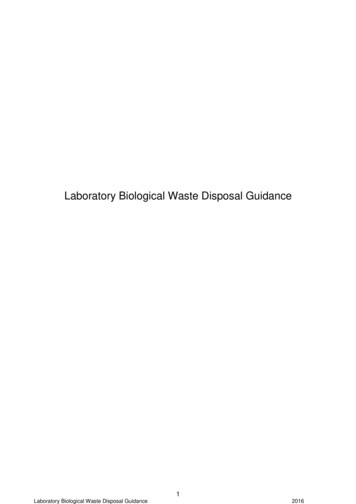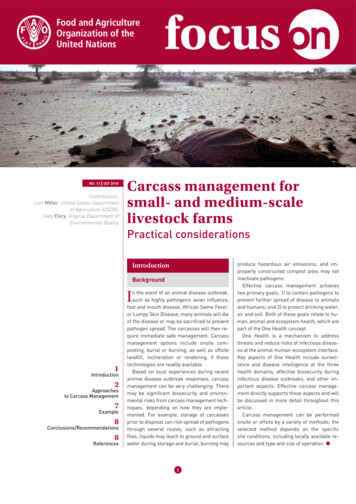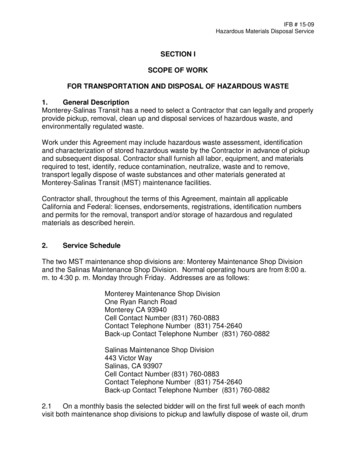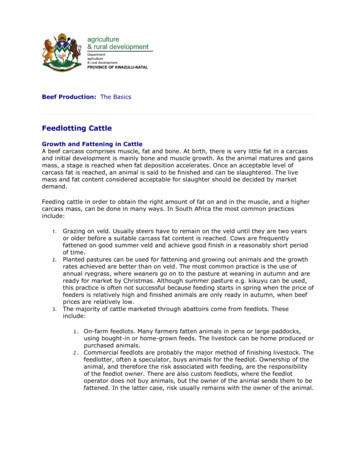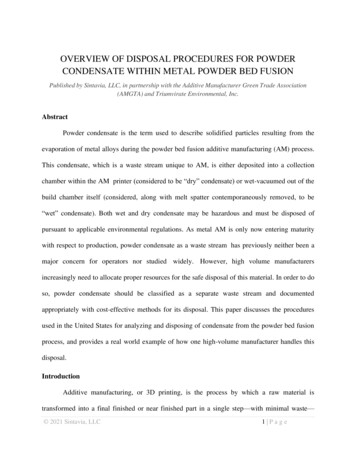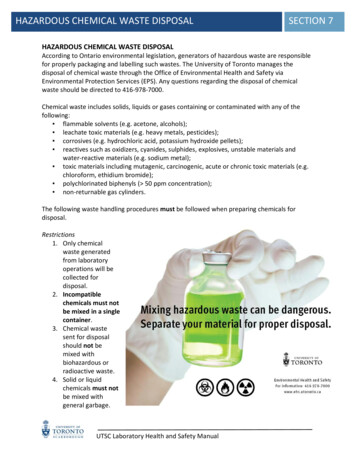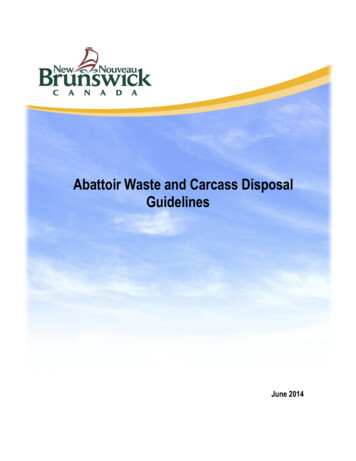
Transcription
Abattoir Waste and Carcass DisposalGuidelinesJune 2014
Table of ContentsIntroduction . 2Definitions . 2On-site Disposal Options . 3Composting: . 3Burial. 3Incineration . 3Off-site Disposal Options. 4Landfill . 4Rendering . 4Incineration . 4Composting/ Burial . 4Selling/ Using Finished Compost . 5SRM Compost . 5Non-SRM Compost . 5Appendix A - Composting and Burial Requirements. 6Appendix B - Minor Burial Disposal – Guidelines. 8Appendix C – Off-site CFIA compost site requirements. . 9Appendix D – Cornell Method. 10Appendix E – References . 10
Abattoir Waste & Carcass Disposal GuidelinesIntroductionThese guidelines merge the New Brunswick Abattoir Waste Disposal Guidelines (2013) and the New BrunswickDepartment of Agriculture and Aquaculture On-Farm Livestock and Poultry Carcass Disposal Guidelines (2005). Theconditions and setback requirements established in the 2013 Guidelines remain in effect in these new Guidelines.It is an underlying principle of these Guidelines that all abattoir waste disposal methods and on-farm disposal ofcarcasses must be performed in such a manner as to protect the environment and human health. The protection ofgroundwater, surface water and air quality are essential while reducing the risk of disease transmission andeffectively preventing access to scavengers and controlling excessive fly activity are also important factors. TheseGuidelines also recognize the need to be economically feasible and socially acceptable while being protective ofhuman health and environment.These Guidelines were developed and approved by the members of the Industry-Government committee onabattoir waste disposal established in 2009. Government was represented by the Departments Health, Environmentand Local Government (DELG), and Agriculture, Aquaculture and Fisheries (DAAF).DefinitionsThe following definitions apply to these Guidelines.“Burial” means to be put in the ground and covered with earth sufficiently to prevent access by scavengers, inaccordance with details provided in Appendix B. It does NOT include being deposited in an open pit for disposal bywildlife scavengers.“Disposal site” means the location where abattoir waste and carcasses are buried, or where the compostingfacility is located.“Minor burial disposal” means in the case of an abattoir operator, a maximum annual amount of abattoir wasteof 20 cubic yards per acre or in the case of a farmer, it means 7000 pounds per year per acre, estimated at seven(7) cattle, forty-four (44) swine, forty-seven (47) sheep or their equivalent.“Minor Composting Facility” means abattoirs or farmers which compost less than 3000 m3 per year of organicmatter. The total organic matter includes the abattoir waste/ carcass and carbonaceous material used in thecomposting process. No Approval to Operate is required.“Major Composting Facility” means abattoirs which compost more than 3000 m3 per year of organic matter,including all abattoir waste and carbon sources. This facility requires an Approval to Operate.“Specified Risk Material” (SRM) is the material which may contain prions – the agent that causes BovineSpongiform Encephalopathy (BSE) in cattle and the variant Creutzfeldt-Jakob diseases in humans.2
Abattoir Waste & Carcass Disposal GuidelinesOn-site Disposal OptionsAbattoir waste and carcasses may be disposed on-site through composting or other site-specific approvedmethods. Proper site selection for any disposal method is integral in protecting the environment and human health.Special consideration must be given to existing zoning laws and land use around the abattoir and disposal site.Specific site requirements are described in Appendices A and B and setbacks are shown in Table 1.Composting:Composting is a biological process in which organic materials are broken down and nutrients are concentratedwithin mature compost. Composting of abattoir waste or carcasses involves layering of abattoir waste or carcassesbetween absorbent carbon sources of material such as wood chips/shavings/ bark, barn animal bedding, hay, straw,etc, in a static pile. A proper ratio of Carbon and Nitrogen sources must be maintained for appropriate composting.Proper construction of the compost pile will allow for proper composting without physically turning and mechanicallyaerating the pile.The temperatures achieved during composting will normally kill or greatly reduce most pathogens. Properlycomposted material is environmentally safe and a valuable soil amendment for growing crops.The Canadian Food Inspection Agency (CFIA) maintains specific requirements for end-use of SRM compost asthis material may contain prions which may not be destroyed in the composting process. As such, it is beneficial tomaintain separate SRM and non-SRM compost piles.See the section titled: Selling/ Using Finished Compost for details about using or selling compost.Composting and site selection requirements: See Appendix A and D.BurialBurial is allowed ONLY for abattoirs/ farmers whose annual volumes of abattoir waste or carcasses meet theminor burial disposal criteria.Burial and site selection requirements are in Appendix B and D.IncinerationIncineration may be used to dispose of all abattoir waste or carcasses. New facilities of this type are subject tothe DELG regulatory requirements and CFIA approvals.3
Abattoir Waste & Carcass Disposal GuidelinesOff-site Disposal OptionsAbattoir operators who wish to dispose of their non-SRM abattoir waste on a non- contiguous site, and livestockoperations who wish to dispose of their non-bovine carcasses on a non- contiguous site, are subject to the sameconditions, setback requirements and methods required for On-Site Disposal.Off-site disposal of SRM abattoir materials and bovine carcasses require CFIA approval and permits for eachstep taken; transportation, disposal (land fill, composting, incineration, burial), end use (if composted). CFIA permitsare also needed for collection systems of bovine carcasses or SRM abattoir waste.For complete permit information, guidelines, setbacks and all permits required for off-site composting orburial, see Appendices A and C and the links to the CFIA website.LandfillNon-SRM abattoir waste may be disposed at a provincially approved landfill.SRM abattoir waste and bovine carcasses may be disposed only at CFIA approved landfills. For a list ofCFIA approved landfills contact your local CFIA office.In all cases, the landfill operator must approve acceptance of the material.RenderingNon-SRM materials may be sent to any approved rendering facility.SRM abattoir waste and bovine carcasses may only be sent to a facility approved by CFIA to receive SRM.IncinerationIncineration may be used to dispose of all abattoir waste and carcasses. New facilities of this type are subject tothe DELG regulatory requirements and CFIA approvals.An incinerator at the provincial veterinary laboratory is available to accept abattoir waste and carcasses. Use issubject to the fee schedule available through DAAF. Permits are required by CFIA to transport all SRM materialsand bovine carcasses to off-site incinerators.Composting/ BurialCFIA permits must be obtained for the off-site composting of SRM. The composting site may be owned by a thirdparty but the compost operator must have a written agreement with the landowner. The compost operator must alsohave a CFIA approved plan for the removal and final use of the finished compost. See next section for details onselling/ using finished compost.CFIA permits must be obtained for the off-site burial of SRM. The property where burial takes place must beowned by the same party which generated the waste.4
Abattoir Waste & Carcass Disposal GuidelinesSelling/ Using Finished CompostSRM CompostOn Farm Use:o The finished compost may be used on lands owned by and contiguous to where the compostwas made. CFIA recommends that the land to which SRM compost is applied should not beused for crops for human consumption, feed, or for grazing by domestic animals for six yearsafter the last application.o No approvals or permits are required from either CFIA or DELG.For Use Off-Site:o The sale of SRM compost is prohibited by CFIA under the Fertilizers Act and Regulations,section V, subsection 5.o CFIA must give approval for the moving of SRM compost off-site and approval for the methodor application of disposal.o CFIA requires a permit for SRM compost to be land applied off-site. It cannot be used on landused for livestock feed, grazing or food production for six years from the time of the lastapplication.o SRM compost must meet or exceed the Category B heavy metal standards of the Guidelinesfor Compost Quality issued by the Canadian Council of the Ministers of the Environment(CCME). Testing the heavy metal levels is required before land application. Results of thesetests must be submitted to DELG.Non-SRM CompostOn Farm Use:o Non-SRM compost may be used on the land owned by the abattoir owner whether contiguousor noto No approvals or permits are required from either CFIA or DELG.For Sale:ooIn order to sell this compost, DELG requires an Approval to Operate issued under theGuidelines for the Beneficial Use of Industrial By-Products as Soil Amendments unless thisproduct has been approved by CFIA under the Fertilizers ActCFIA may also need to give approval for the sale of Compost under the Fertilizer’s Act.5
Abattoir Waste & Carcass Disposal GuidelinesAppendix A - Composting and Burial Requirements1. Regulatory AuthorityDELG regulates composting facilities as per the Water Quality Regulation – Clean Environment Act. As such,DELG reserves the right to require an Approval to Operate to any composting facility that is causing anadverse affect on the environment or is not operating in accordance with the guideline.All composting and burial must be performed in a manner which ensures that there is no harm to theenvironment or endangers human health.Disposal of abattoir waste or carcasses in excess of the volumes allowed under the Minor Composting Facilitycategory are considered a Major Composting Facility. Major Composting Facilities require an Approval to Operatefrom DELG, which may include additional requirements.2. Disposal Site SelectionTable 1 shows the minimum separation distances between the disposal site and receptors to minimize potentialconflicts between non-compatible land uses, odour-related problems and noise, and to protect the integrity ofgroundwater systems. Any variation to the methods and/or setbacks outlined in these Guidelines requires anapproval from the Variance Committee. It is imperative that abattoir operators and farmers protect the adjacent landowners and the environment from harm created by the disposal of these materials.In order to prevent the spread of disease/pathogens/contaminants, disposal site operators must prevent vectorsand animal scavengers from accessing the offal, carcasses and/or the compost pile. All equipment used in thecomposting or handling process of SRM should not be used for other purposes, unless it is thoroughly cleaned anddisinfected before leaving the site where the SRM is being processed.3. Variance RequestsIf set back distances cannot be met, a variance request may be submitted to the Variance Committee. Additionalinformation may be required if the proposed disposal site has setback distances less than those indicated in the tableabove.4. Disposal Site methodologyThe disposal site should be managed so as to limit vectors, odour, noise, and leachate generation. As aminimum, the Cornell method referred to in Appendix D should be followed.A table outlining some methods is provided as an example in the Cornell information. Refer to thespecification from the best practices available.6
Abattoir Waste & Carcass Disposal Guidelines5. Monitoring Requirements (Environmental & Compost Pile Conditions)Site-specific monitoring is important to ensure the composting process is working properly as well as forenvironmental protection purposes.Temperatures should be monitored in specific locations within a pile and must reach 55 degrees Celcius forthree consecutive days to kill pathogens. Locations and frequency of temperature monitoring can be determinedbased on best practices for the construction method chosen. Visual inspections for odour and vector control areimportant to ensure the integrity of the pile. Leachate collection and surface water or ground water monitoring shouldbe considered.Table 1: SETBACK DISTANCES (meters) for Disposal Sites for Abattoir Waste and CarcassesCOMPOSTINGParameterPotable WellsDwellingWatercourses/WetlandsProtected Wellfields/WatershedsFlood PlainsAdjacent PropertiesInstitutional/Commercial PropertiesFarmPublic Roads/TrailsIndustrial BuildingsInternational/Provincial BordersMajorCompostFacility500300100Not 100Not 00100100OTHERIncinerationRenderingNON – SRMTBD““““““““““Not sYesNoNoNoNoNo30Other RequirementsDELG Approval to Operate requiredYesNoNoCFIA permit required for on-site disposalNoNoNoCFIA permit required – off-site SRM disposalYesYesYesCFIA permit required – off-site non SRM useNoNoNoCFIA permit to transport SRM requiredYesYesYes** See Appendix B for complete Burial Guidelines for Minor Disposal Volumes** Operator must also comply with local municipality and district planning commission regulations.7
Abattoir Waste & Carcass Disposal GuidelinesAppendix B - Minor Burial Disposal – GuidelinesBurial of abattoir waste or carcasses that meet the volumes allowed under the definition of minor burial disposalshall be done in accordance with the following details.1. SRM abattoir waste and bovine carcasses may be disposed on land owned by the same party as the oneproducing the waste. It may not be disposed on lands owned by a third party.2. Non SRM abattoir waste and other livestock carcasses may be disposed on lands either owned by thesame party or who have a long-term lease with at least one (1) year remaining on the lease and thepermission of the landowner;3. The burial site shall not be located within protected areas such as designated well fields and watersheds asdefined in the Clean Water Act and should not be located near tile drainage systems;4. No waste other than the abattoir waste or carcasses shall be deposited in the excavation at the site;5. The burial site shall not exceed a land area of one acre; and the abattoir waste/ carcasses placed in the sitewill not exceed a layer depth of one (1) meter and will not exceed 20 cubic meters of abattoir waste or 7000pounds of carcasses per year per acre.6. Disposal shall not take place on a sand and gravel deposit, on a floodplain, or on any area with a slopegreater than 8%;7. Disposal shall take place a minimum of one (1) meter above the seasonal high water table and a minimumof 1.3 meters above bedrock;8. No disposal shall take place within 100 meters of a watercourse or wetland;9. There shall be a minimum 30 meters buffer between the disposal area boundary and the property boundaryunless the adjacent property is owned or leased on a long-term basis with permission of the property owner;10. No disposal shall take place within 100 meters of the nearest residence;11. No disposal shall take place within 300 meters of the nearest well;12. Immediately following placement in the burial pit, the abattoir waste/ carcasses shall be covered with aminimum of one (1) meter of soil. The surface will be mounded and seeded with vegetation;13. When the ground is frozen, the Cornell type method of above ground burial is recommended. No materialis to remain uncovered. All material must be sufficiently covered/ buried to control vector activity.14. The disposal site operator is encouraged to record the burial location.Staff from the Department of Agriculture, Aquaculture and Fisheries are available to producers to go on-site toassist with choosing a site that meets these requirements in order to protect the environment.8
Abattoir Waste & Carcass Disposal GuidelinesAppendix C – Off-site CFIA compost site requirements.Composting SRM material on-site is not regulated by CFIA. However once SRM material is moved off-site,CFIA requires a permit to move the SRM material and a permit from the abattoir operator to compost or to bury it. Allprovincial and municipal rules, regulations and setback requirements also apply. (see Table 1 in Appendix A)The required CFIA application must include:1. A letter or other document that shows the planned disposal is permitted by local authorities(municipality/province).2. Site plan and normal operating procedures3. In the case of a composting operation, a clear indication of the location(s) where the composted SRM willultimately be disposed (e.g. letter of intent).Disposal site requirements:1. A physical barrier of some sort (e.g. fence and locked gate) which prevents entry of people and domesticruminant livestock. Signage indicating contact info and hours of operation must be posted.2. The base must be of limited porosity (1 x 10(-7) cm / sec or less). The base can be natural material e.g. clayor man-made, or concrete or liner/tarp as long as its integrity will not be compromised (the tarp won't be ripped) bynormal operating procedures at the site. If natural material is not clearly visible there would have to be evidencedemonstrating its composition e.g. demonstrate that it is clay. The base in combination with the addition of asufficient carbon source can be used to control leachate (leachate collection system).3. Some form of barrier or alternate approach is required to prevent scavenging and precipitation hitting thecompost e.g. roof or cover (tarp) covering the entire compost pile. Adequate run off of precipitation can be ensuredby placing compost pile on a slight hill (not a valley) or mounding the compost so that all precipitation will run off thesides of the cover.4. Equipment that touches the compost must be used only for compost, or the parts of the vehicle that are incontact with SRM must be pressure washed before leaving the site.5. Staff that work on the site must be trained.6. Records must be kept in accordance with the regulationsAny sites/circumstances that do not meet the above will be evaluated on a case-by-case basis utilizing theprocess outlined in the document "criteria for evaluation of alternate approaches to controlling/destroying SRM" datedJune 27, 2006.The following links gives CFIA’s requirements and application 3287457769
Abattoir Waste & Carcass Disposal GuidelinesAppendix D – Cornell MethodThe Cornell method for disposing of abattoir waste, including SRM, and carcasses of all types of livestock is anacceptable manner of disposing of this material. The following links are the methods recommended by ttakes.pdfAppendix E – References1. Guidelines for the Site Selection, Operation and Approval of Composting Facilities in New Brunswick (NBDepartment of Environment and Local Government)2. Guidelines for Siting Compost Operations, November 2005 (Maine Department of Agriculture)3. Best Management Practices for Large Animal Carcass Composting, June 2009. (Maine Department ofAgriculture, Food and Rural Resources4. On-Site Composting Facility for Abattoir Inedible Materials, June 2009. ON Ministry of Agriculture, Food &Rural Affairs5. Operations Manual for Offal Compost Facility (Maine)6. Natural Rendering: Composting Livestock Mortality and Butcher Waste, 2002. (Cornell Waste ManagementInstitute)7. New Brunswick Abattoir Waste Disposal Guidelines (2013)8. On-Farm Livestock and Poultry Carcass Disposal Guidelines, 2005 (NB Department of Agriculture,Aquaculture & Fisheries)9. Guidelines for the Beneficial Use of Industrial By-Products as Soil Amendments, 2014 (NB Department ofEnvironment and Local Government)10
These guidelines merge the New Brunswick Abattoir Waste Disposal Guidelines (2013) and the New Brunswick . An incinerator at the provincial veterinary laboratory is available to accept abattoir waste and carcasses. Use is subject to the fee schedule available through DAAF. Permits are required by CFIA to transport all SRM materials
